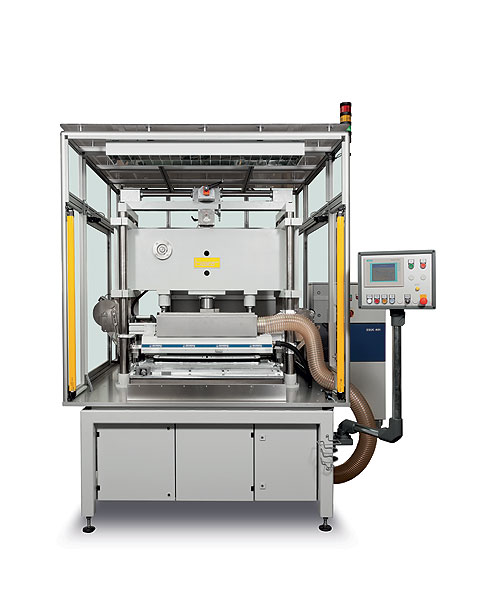Q&A: Hot Stamping 3D Parts
Plastics Decorating
In the past, plastic elements with a curved part geometry typically have been decorated by means of galvanization, which requires two injection-molded parts. A new process developed by KURZ Transfer Products, L.P., Lexington, NC, allows a single-component panel to be partially coated with a metallic, patterned or pigmented foil. This finishing method, according to Allan Quimby, area sales and marketing manager - plastics for KURZ, eliminates the need for an injection mold, along with the associated molding operation and assembly step and, therefore, offers significant cost advantages.
Question: How does the 3D hot stamping process differ from normal hot stamping?
Answer: The 3DHS coating process requires three components that have been optimally tailored to one another: a special hot stamping foil, a 3DHS die system and the 3DHS machine. The hot stamping foil developed by KURZ has been specially formulated to meet the requirements of three-dimensional decoration. It has a high elasticity, which enables it to be thermally shaped to match the geometry of the plastic part in a work operation prior to the stamping process.
In a normal hot stamping process with heat and pressure, pressure is applied in a vertical motion to the foil and the substrate to make a transfer. In this application, a vacuum is pulled down over the foil and the foil is pre-heated to give it the elasticity it needs. Then the vacuum is pulled even tighter over the part, and a heated die is brought down to ensure adhesion and make the impression.
Question: What are its advantages?
Answer: One of the main advantages of the process is the ability to avoid wrinkles. In the past, if a designer wanted to decorate the outer ring of a part, that normally only could be done if the part geometry was flat and consistent. In traditional hot stamping, wrinkles can become an issue if the part geometry has not been designed for a suitable hot stamp, but the vacuum and the flexibility of the foil in the 3DHS process eliminates that concern.
The cycle time for the 3DHS process is longer than traditional hot stamping because of the drawing of the vacuum, but the amount of extra time necessary is project- and size-dependent. Cycle time, however, as it relates to alternative decoration mediums, is very competitive. It often could be considered to be faster because of the modular design and ability to place the decoration inline in the manufacturing process.
Another advantage of the 3DHS technology is that it is more environmentally friendly and versatile since design changeovers can be performed simply by exchanging the hot stamping foil. Color changes in chrome plating require a change and disposal of the plating bath, which typically consists of hazardous solutions – either a chromic acid solution or a less toxic solution based on trivalent chromium salts. The traditional metalizing process involves application guns and either combustible gasses or compressed air. The 3DHS is a dry and solvent-free process that makes a spraying tool and a spray procedure unnecessary, which again leads to cost savings.
Question: How does this impact the design process?
Answer: This technology gives designers a little more freedom of design. They can think in three-dimensional shapes and still avoid some of the hazardous processes, such as chrome dipping and plating, by using a hot stamping solution. Studies from KURZ show that 3DHS could be a fraction of the cost of a traditional coating or plating process. This is, of course, part size- and volume-dependent. Applications could include automotive interior and exterior applications, household appliances, electronics, consumer goods, health and beauty aids and many others.
In addition, KURZ can support chrome foils that are 100-percent corrosion-resistant and are used on many outdoor and automotive applications. The wear resistance also is built into the construction of the foils, with robust topcoats to pass the most difficult wear and abrasion testing.
For more information on the 3DHS process, call 800.950.3645 or visit www.kurzusa.com.


